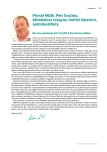Guidelines of Czech Association for Thrombosis and Haemostasis of the Czech Medical Association of J. E. Purkyně for safety treatment with new oral anticoagulants (NOAC) – dabigatran etexilate, apixaban and rivaroxaban
Authors:
Jan Kvasnička 1; Miroslav Penka 2; Tomáš Kvasnička 1; Jana Michalcová 2; Zuzana Kudrnová 1; Ivana Malíková 1
Authors‘ workplace:
Trombotické centrum Ústavu klinické biochemie a laboratorní diagnostiky 1. LF UK a VFN Praha, přednosta prof. MUDr. Tomáš Zima, DrSc., MBA
1; Oddělení klinické hematologie FN Brno, primář prof. MUDr. Miroslav Penka, CSc.
2
Published in:
Vnitř Lék 2015; 61(6): 537-546
Category:
Guidelines
Overview
There are presently new oral anticoagulants (NOAC) for prevention and the treatment of thromboembolic diseases and they are registered in CZ. It concerns of orally direct inhibitors of thrombin (dabigatran etexilate), inhibitors of factor Xa (apixaban, rivaroxaban), respectively, with advantage of some properties not being seen in „classical” anticoagulants. In the use of new anticoagulants, however, are some problems – such as laboratory monitoring in urgent situations of effective treatment and the absence of specific antidote – resolved. The text below brings indications, dosage of the drugs, their elimination, follow-up of efficacy of the treatment or risk of the bleeding as well as the therapy of bleeding complications.
Key words:
apixaban – dabigatran etexilate – NOAC – rivaroxaban
Sources
1. The European Medicines Agency. Souhrn údajů o přípravku Pradaxa. [online]. Dostupné z WWW: <http://www.emea.europa.eu/docs/cs_CZ/document_library/EPAR_-_Product_Information/human/000829/WC500041059.pdf>.
2. The European Medicines Agency. Souhrn údajů o přípravku Xarelto. [online]. Dostupné z WWW: <http://www.emea.europa.eu/docs/cs_CZ/document_library/EPAR_-_Product_Information/human/000944/WC500057108.pdf>.
3. The European Medicines Agency. Souhrn údajů o přípravku Eliquis. [online]. Dostupné z WWW: <http://www.ema.europa.eu/docs/cs_CZ/document_library/EPAR_-_Product_Information/human/002148/WC500107728.pdf>.
4. Čihák R, Haman L, Táborský M. European Heart Rhythm Association practical guide on the use of new oral anticoagulants in patients with non-valvular atrial fibrillation. Summary of the document prepared by the Czech Society of Cardiology. Cor et Vasa 56(2014) e42–e56. Dostupné z WWW: <http://www.sciencedirect.com/science/article/pii/S001086501300129X>.
5. Čihák R, Haman L, Heinc P. Souhrn Aktualizace doporučených postupů ESC pro léčbu fibrilace síní z roku 2012. Cor Vasa 2012; 54: e341-e351. Dostupné z WWW: <http://www.sciencedirect.com/science/article/pii/S0010865012001257?v=s5>.
6. Heidbuchel H, Verhamme P, Alings M et al. European Heart Rhythm Association Practical Guide on the use of new oral anticoagulants in patients with non-valvular atrial fibrillation. Europace 2013; 15: 625–651. Dostupné z DOI: <http://doi: 10.1093/europace/eut083>.
7. Penka M, Penka I, Gumulec J et al. Krvácení. Grada Publishing: Praha 2014. ISBN 978–80–247–0689–4.
8. Baglin T, Hillarp A, Tripodi A et al. Measuring Oral Direct Inhibitors (ODIs) of thrombin and factor Xa: A recommendation from the Subcommittee on Control of Anticoagulation of the Scientific and Standardisation Committee of the International Society on Thrombosis and Haemostasis. J Thromb Haemost 2013; 11(Suppl 2): 765–760.
9. Kvasnička J, Malíková I. Nová perorální přímá antikoagulancia (NOAC) – jak řešit možné problémy s vyšetřením koagulace. Anest Intenziv Med 2014; 25(5): 367–372.
10. Tsakiris DA, Alberio LA et al. Quantifizierung von Rivaroxaban und Beeinflussung von Gerinnungstests bei Patienten mit Rivaroxaban (Xarelto®) [online]. 2012. Dostupné z WWW: <http://www.sgh-ssh.ch/upload/File/2012_11.10._Rivaroxaban_D.pdf>.
11. Kozek-Langenecker SA, Afshari A, Albaladejo P et al. Management of severe perioperative bleeding: guidelines from the European Society of Anaesthesiology. Eur J Anaesthesiol 2013; 30(6): 270–382.
12. Siegal DM, Crowther MA. Acute management of bleeding in patients on novel oral anticoagulants. Eur Heart J 2013; 34(7): 489–498b.
13. Khadyzhynov D, Wagner F, Formella S et al. Effective elimination of dabigatran by haemodialysis. A phase I single-centre study in patients with end-stage renal disease. Thromb Haemost 2013; 109(4): 596–605.
14. Yeh CH, Hogg K, Weitz JI. Overview of the new oral anticoagulants: opportunities and challenges. Arterioscler Thromb Vasc Biol 2015; 35(5): 1056–1065.
15. Greinacher A, Thiele T, Selleng K. Reversal of anticoagulants: an overview of current developments. Thromb Haemost 2015; 113(5): 931–942.
16. Hippisley-Cox J, Coupland C. Predicting risk of upper gastrointestinal bleed and intracranial bleed with anticoagulants: cohort study to derive and validate the QBleed scores. BMJ 2014; 349: g4606. Dostupné z DOI: <http://doi: 10.1136/bmj.g4606>.
17. Ageno W, Crowther M, Baglin T et al. Selection and assessment of patients treated with the novel oral anticoagulant drugs: a recommendation from the Subcommittee on Control of Anticoagulation of the Scientific and Standardisation Committee of the International Society on Thrombosis and Haemostasis. J Thromb Haemost 2013; 11(1): 177–179.
Labels
Diabetology Endocrinology Internal medicineArticle was published in
Internal Medicine

2015 Issue 6
Most read in this issue
- Diagnosing and therapy of gout
- Alveolar echinococcosis – rare cystic disease of the liver – editorial
- Guidelines of Czech Association for Thrombosis and Haemostasis of the Czech Medical Association of J. E. Purkyně for safety treatment with new oral anticoagulants (NOAC) – dabigatran etexilate, apixaban and rivaroxaban
- “Stressful holiday” – takotsubo cardiomyopathy
